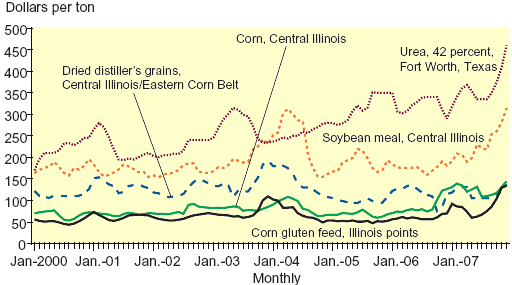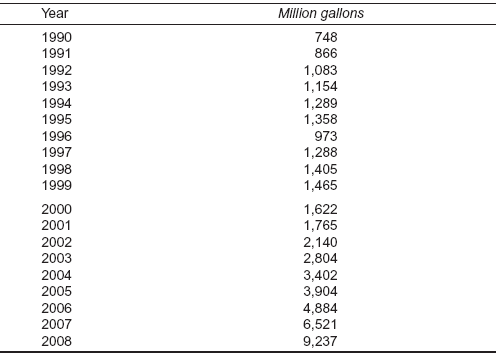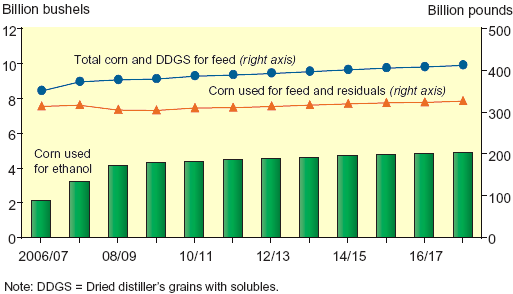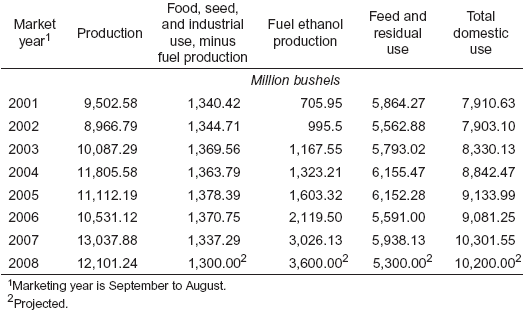



Ethanol Co-Product Use in U.S. Cattle Feeding
The expansion of the ethanol industry led to increased demand for corn and an increased supply of co-products from the ethanol production processes, says the USDA Economic Research Service.
Introduction
Concurrently, high global commodity prices, attributed to increased global demand for food and feed, poor weather conditions in some major cropproducing areas, and the worldwide expansion of biofuel production, have detrimentally impacted the livestock feeding industry (Trostle, 2008). Co-products from ethanol, sweeteners, syrup, and grain-based oil production have been used as livestock feed for many years, but only recently have become a more widespread economic alternative for coping with high prices for feedstuffs such as corn, soybean meal, and urea (fig. 1). Dairy cattle operators have the most experience of agricultural producers who use co-products. Dairy operators, surveyed by the National Agricultural Statistics Service (NASS) in 2007 indicated that, on average, they had fed co-products 9.2 years (USDA, NASS, 2007). Cattle feeders and cow-calf operators indicated they have used them, on average, for 5.1 years and 4.6 years, respectively. Co-product feeding is relatively new for hog operations, with survey respondents indicating they had used co-products 2.7 years on average.
Figure 1: U.S. prices for selected feedstuffs

Source: USDA, ERS, Feed Grains Database, www.ers.usda.gov/Data/FeedGrains/.
Ethanol plants increasingly compete with livestock feeders for corn. However, ethanol production also results in co-products that can be substituted as sources of energy and protein in livestock feeding (table 1). The removal of starch through ethanol and sweetener production reduces the quantity of the feedstuff available in a bushel of corn or other grain. For example, a bushel of corn (56 pounds) that yields 2.6 to 2.8 gallons of ethanol reduces in the dry-mill process to about 17.5 pounds of dried distiller’s grains with solubles containing 10-percent moisture. The same bushel in the wet-mill process reduces to 11-13 pounds of corn gluten feed, 2.6 pounds of corn gluten meal, and 1.6 pounds of corn oil (Biomass Research and Development Board, 2008; Westcott, 2007; Sevcik, 2006; Wisner, 2007; Shapouri, 2009).
Co-products have been supplied historically from industrial uses of corn and other grains, which have grown in recent years with increased ethanol production (table 2). While some corn usage for feed has been diverted to ethanol production, reducing feed uses of corn and other grains, the bulk of increased ethanol-driven corn usage has come from increased corn acreage, often a result of reallocating crop acreages. As a result, the total supply of grain-based feeds is expanding (fi g. 2). Thus, the increased availability of co-products has actually increased feed supplies (table 3). This has led to expanded interest in feeding co-products and periods of favorable relative prices have increased their substitution for corn.
Co-products made from grain-starch-based and corn-oil products include corn gluten feed (CGF), corn gluten meal (CGM), wet distiller’s grains with solubles (WDGS), dried distiller’s grains without solubles (DDG), dried distiller’s grains with solubles (DDGS), and solubles alone (condensed distiller’s solubles (CDS)).
Table 1: Nutrient profi les of selected feedstuffs

Source: Feedstuffs: 2009 Reference Issue and Buyers’ Guide, 2008.
Table 2: U.S. ethanol production

Source: U.S. Department of Energy, Energy Information Administration. http://www.tonto.eia.doe. gov/dnav/pet/pet_pnp_oxy_dc_nus_mbbl_m.htm/.
Figure 2: Total feed projections

Source: USDA Agricultural Projections to 2018, www.ers.usda.gov/publications/oce091/.
Table 3: Corn provides inputs into both feed and ethanol production

Source: USDA, ERS, Feed Grains Database, www.ers.usda.gov/Data/FeedGrains/.
Considerations for the Future
The use of co-products in feed for U.S. dairy, meat, and poultry production will be affected by a number of competing factors. The development and growth of the ethanol industry will affect the availability of corn for feed, increasing competition in the corn market. As the ethanol industry grows, there will be a corresponding increase in co-products available to substitute for corn in animal feed.
Ethanol production increased 232 percent between 2003 and 2007, rising from 2.8 billion gallons to 6.5 billion gallons (table 2). The Energy Independence and Security Act of 2007 established the Renewable Fuel Standard (RFS) which mandates the use of biofuels at 11.1 billion gallons in 2009 rising to 36 billion gallons in 2022. Some of the 36 billion gallons is to come from cellulosic ethanol and other advanced biofuels. The maximum amount of corn-based ethanol that can be used to meet the RFS increases from 9 billion gallons in 2008, to 15 billion gallons in 2015. If all 15 billion gallons were produced from dry-milling corn, as much as 98 billion pounds of DDG could be produced from 5.6 billion bushels of corn.
Co-products add to the options available to informed livestock producers to develop the best feeding strategies possible. Increased education of and outreach toward livestock and poultry producers about how best to use co-products as animal feed will infl uence how operators adapt the new co-products to future feed rations. New information on co-products’ nutritional values, distribution possibilities, and other aspects will be disseminated to the livestock industry through extension offi ces and publicly available research, among other forms of communication.
Further Reading
| - | You can view the full report by clicking here. |
May 2009


